La Cotinière, Île d’Oléron
Photography made easy
by La Cotinière
Except for Corsica, the idyllic Île d’Oléron is the largest of the French islands. That being said, it is only 6km wide (3.7miles) and about 30km long (18.6 miles). It lies about 40 minutes drive south of better known La Rochelle and its adjacent smaller, but also charming, island of Ré.
The climate is almost Caribbean in type: usually mild in winter and refreshed in summer by constant sea breezes. Like any ocean island it is susceptible to major storms that over the centuries have caused flooding and wind damage to the settlements, but generally it is an idyllic place with a luminous quality to its light that has always attracted artists.
La Cotinière is the leading
seafood harbour of the Charente-Maritime region, and the eighth in importance all of
France.
It is a place where it seems difficult to take a poor photograph, whether by day, as when I arrived late in the afternoon…
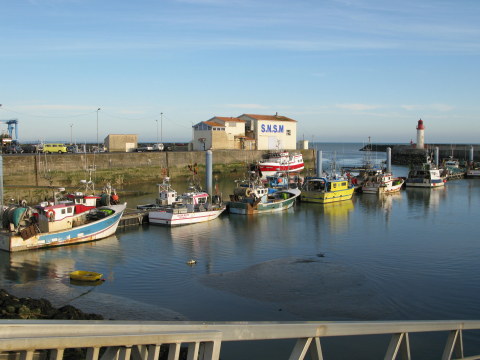
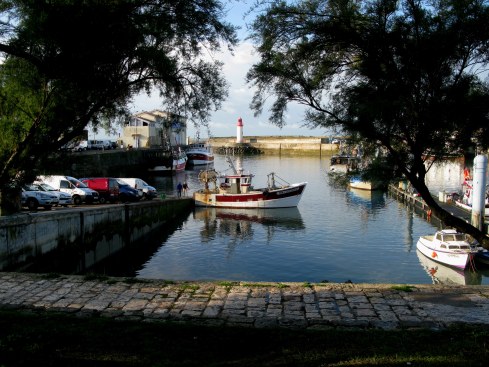
…or by night, when its lies as if in some luminous postcard…
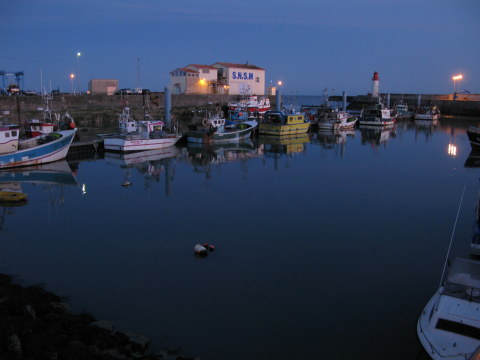
…waiting for the fishermen to bring the resting boats to life.
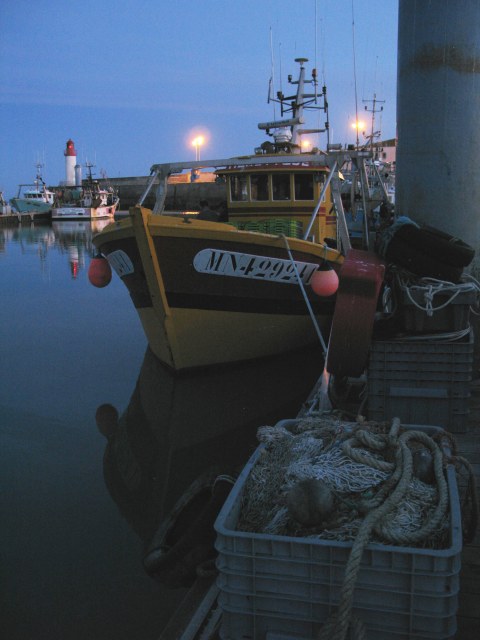
As the night drew in, the magic just seemed to increase, as light warmed the dark harbour with golden ripples.
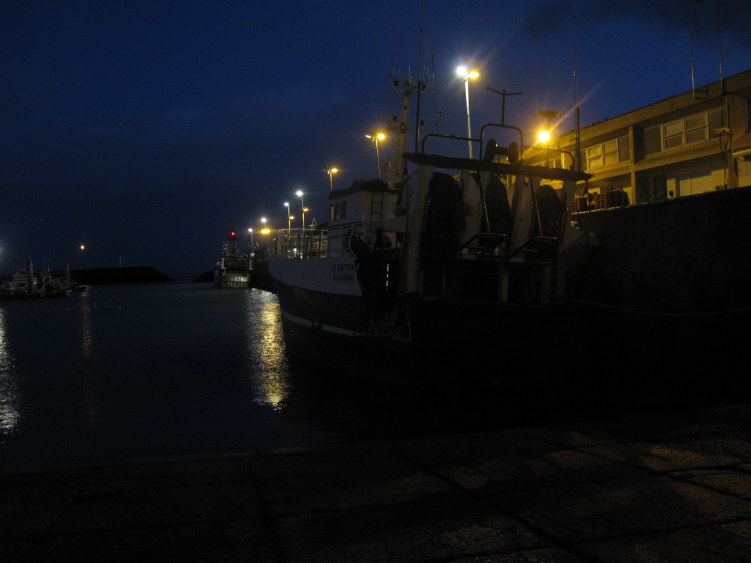
The lighthouse on the rocky point that defines the harbour entrance has a four second light and dates back to 1955. The other more traditionally built red and white lighthouse at the end of the jetty was first lit in 1899, being modernised to a propane lamp in 1939.
This evening it was the newer one that flashed out its particular warning, faintly seen on the promontory in the distance as it beamed seaward.
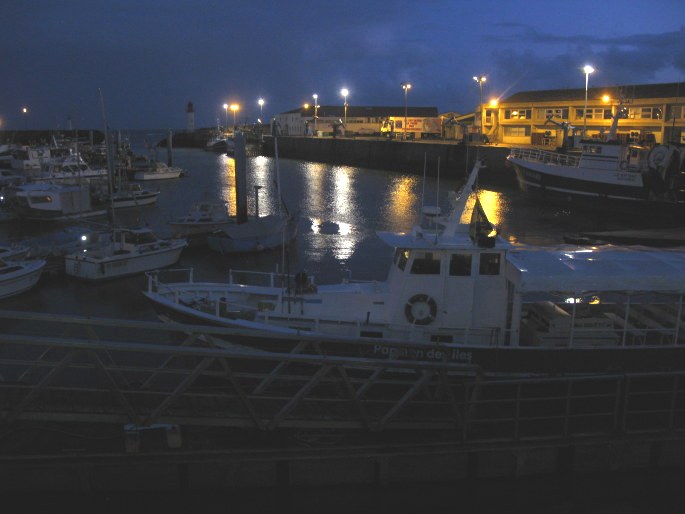
La Cotinière: one of the big three fishing ports of Charente-Maritime
La Cotinière is the largest and most important of what are known as the 'big three' fishing ports of the Charente-Maritime region, the other two being La Rochelle and Royan.
The annual catch is over 5,200 tonnes of fish of over 90 species. These are sold at the daily electronic auction on the dockside. Here they sell fish from the whole of Oléron and this auction is reputably the most modern of its kind in all of France.
The mix of species has varied over the centuries. For many years La Cotinière was the leading shrimp port: it also specialises in the seasonal catch of flat sole, but in the early 18th centur, sardines were a major catch and an important staple of the local economy.
The fishing grounds around Oléron supplying both fish and molluscs are some of the most valuable in Europe. As long-time beneficiaries of their largess, the fishermen of the island have been active in working with federal and regional agencies to manage the important fishing grounds of the whole Charente Marennes region.
Fishing boats of various sorts
in La Cotinière
There are around 75 fishing boats of different types whose home port is La Cotinière.
There are trawlers …
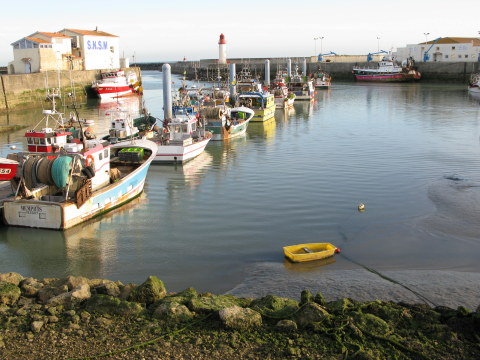
…those that troll – dragging lines with hooks, as well as side trawlers deploying long nets.
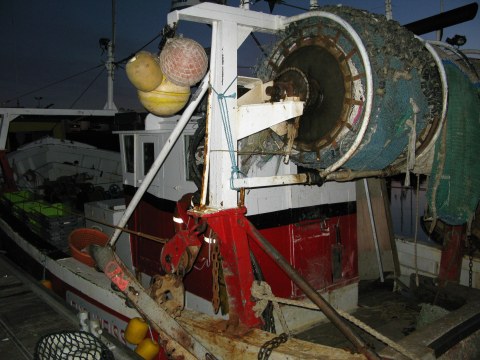
The vehicles used by the local fishermen reflect decent incomes.
Together with living and working in a place that is constantly beautiful, it must make for a rewarding lifestyle, despite the sometimes vicious currents of the Straits of Pertius.
These straits and the Atlantic fishing grounds used by the fishermen, bring occasional tragedies. Boats and crew lost at sea are the dread of every fishing community.
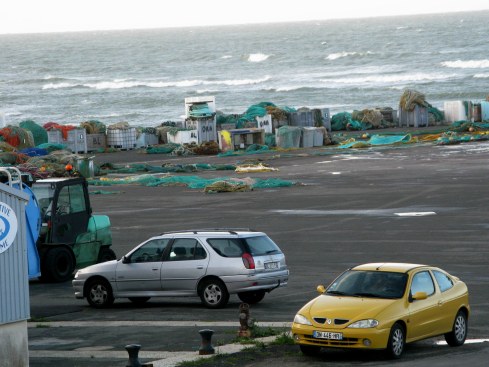
A commercial port with lots of lift
But is not every port that demands, or can afford, a 200 tonne marine travel lift.
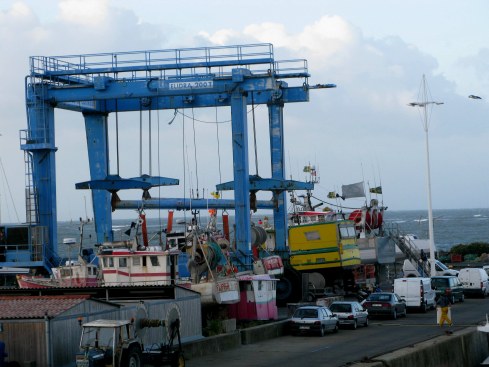
Fishing boats returning
to La Cotinière
It is quite a sight to watch the returning fishing boats.
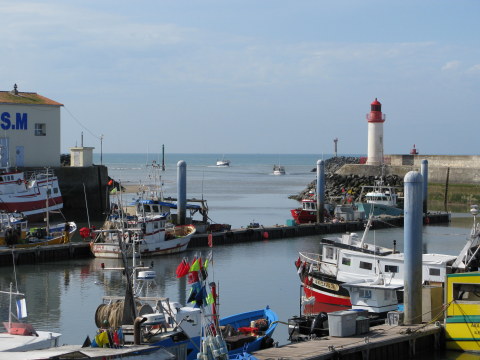
I had been standing on the heads by the lighthouse as they started to return and drove back around to the sandy coast to be able to see them negotiating the sandbars around La Cotinière as they bore their catch back to port.
The contrast in size between trawler and small fishing boat doesn’t mean that the earnings of the smaller vessel may differ significantly for the individual fishermen because they focus on different types of fish, each with their niche market.
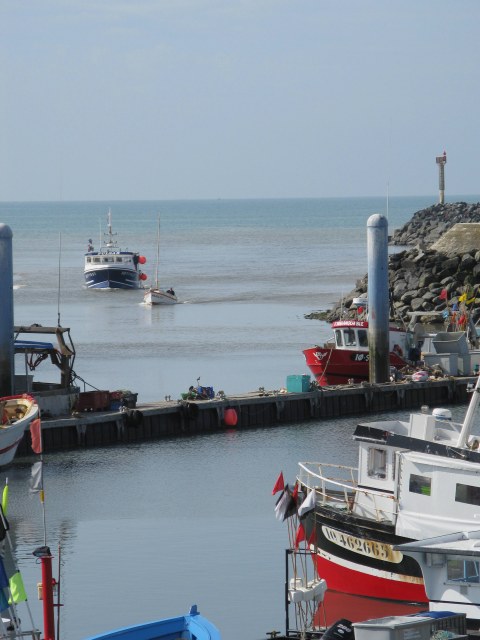
Perhaps the smaller vessel was bringing shellfish, or perhaps he had been trolling, with lines and hooks instead of nets.
A trawler pulled alongside what looked like a giant vacuum cleaner at the mouth of the harbour.
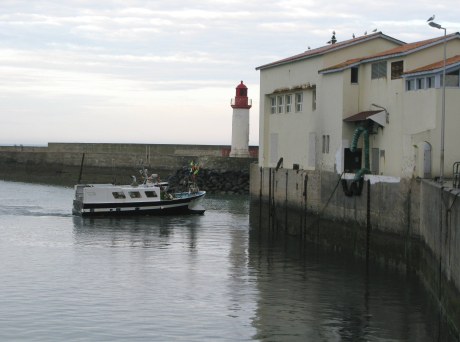
This was the first stop for several but not all vessels, and presumably depends on the nature of the catch.
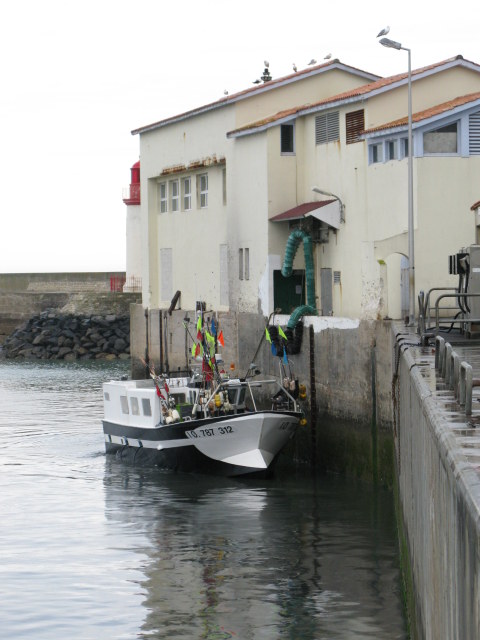
The trawler then pulled alongside where a series of cranes are ready.
A crew member climbed up the ladder to haul up crates of sorted seafood on ice ready for the La Cotinière commercial fish auction that has made the name of Oléron synonymous with finest quality seafood.
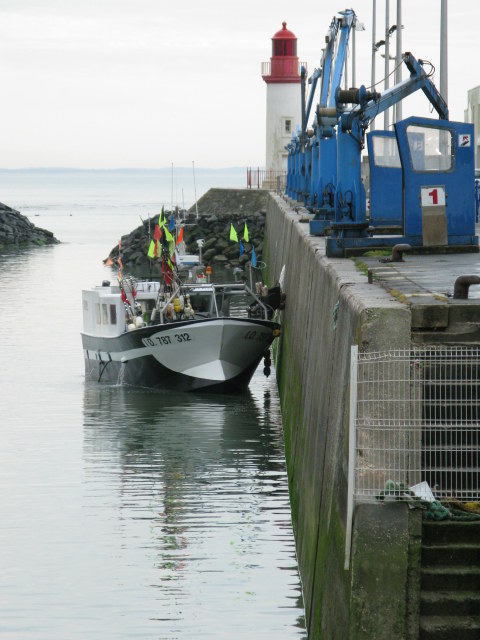
Before long all the cranes were busy.
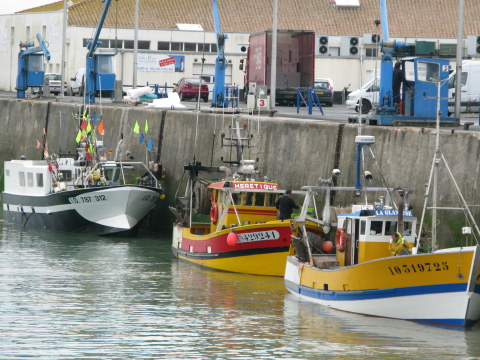
Then, returning to their moorings, the unloading of gear began.
It certainly took less time than for most for this small fishing boat to return to its berth.
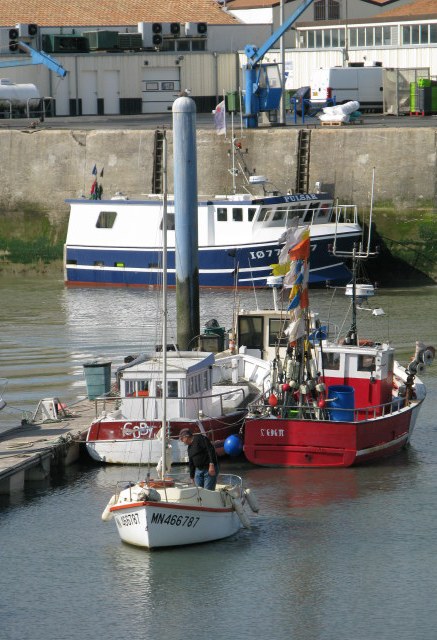
On another day after blustery winds had lashed the coast with squalls of heavy rain, this returning fishing boat seemed to scurry thankfully through the port entrance.
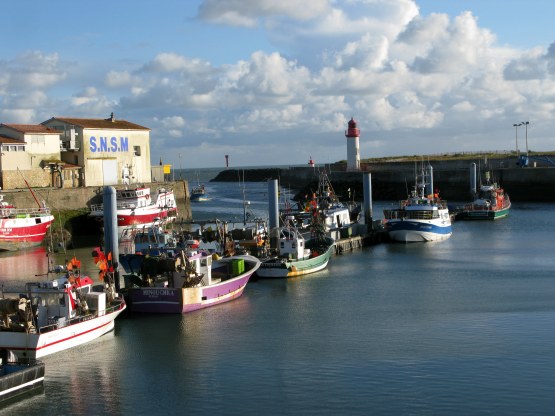
At this hour he had the loading area to himself.
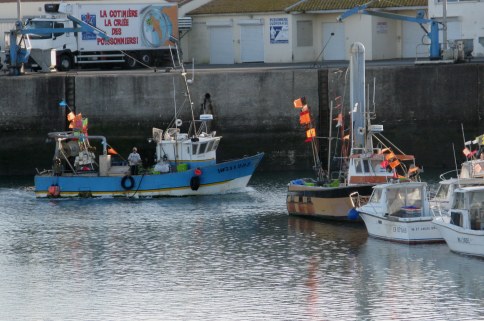
By the time he docked a team was ready.
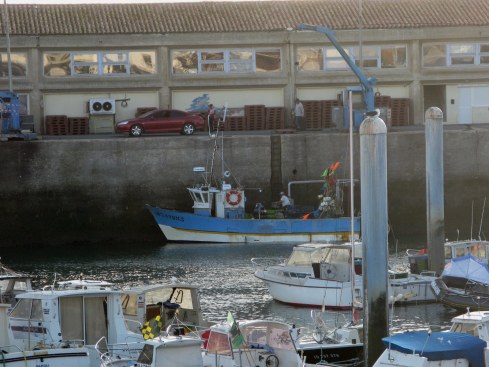
His catch were already stacked in plastic crates that were hauled quite rapidly to the sales warehouse to be packed and shipped.
As I watched the activity beyond, I noticed that there was a marine honour guard lining the gangway to the floating pontoon above which I was standing.
Facing into the wind, seagulls were ranked on either side of the hand rail.
La Cotinière is the pearl
in the Oléron necklace of beauty.
La Cotinière is the sort of place that draws you back.
To me it is the loveliest pearl in a necklace of beauty that encircles Oléron.
The eternal attraction of the ocean and the men who work it seems universal and this is a remarkably lovely port.
On another day after blustery winds the returning fishing boat seemed to scurry thankfully through the port entrance.
As I soaked up the scenes of the port and thought of the wild seas the fishermen would have encountered in their careers, I smiled in thinking of how Space Odyssey author Arthur C. Clarke quite rightly pointed out:
How inappropriate to call this planet Earth,
when it is quite clearly Ocean.
Gone fishing!
Fishing is not just about the physical catching of fish. The catch must also be sorted and graded and then arranged in flat plastic trays.
This is how the catch is presented to the daily commercial fish market that takes place in the dockside sheds of La Cotinière.
It is also how the chefs receive their ingredients for today's menu.
Dining on fish freshly caught
by the fisher folk of La Cotinière
Later, I was eager to sample some of Oléron’s seafood and smiled as I walked around reading menus posted on the walls outside. They reminded me of the quote I had read somewhere by the well known 'Anonymous'…
'Carpe Diem'
does not mean catch of the day
I was finally drawn to the Restaurant l'Ecailler which overlooks the port and is also a hotel.
Having read of its location I had contemplated staying there, but it was probably just as well I didn’t because the food there was so good I may never moved far away from it to explore the rest of this spectacular little jewel of an island.
However, years later Oléron called me back and this was my accommodation of choice.
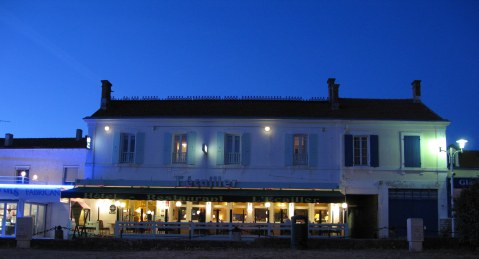
On that first visit, as I entered, some diners had just received their La Cotinière Seafood Platter.
I was so amazed at the sight I asked would they mind if I took a photo.
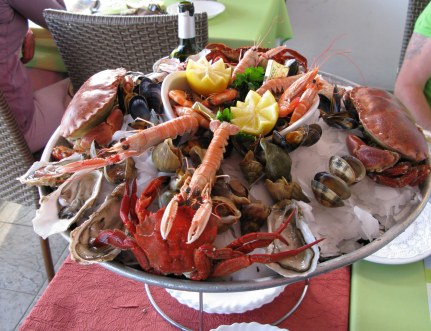
Having seen this piece of culinary seafood art it wasn’t difficult to choose from a menu that would otherwise have had me pondering a selection while salivating in anticipation of fresh seafood at its best.
I ordered a smaller version of the seafood platter for myself.
It was just as magnificent – and all for me!
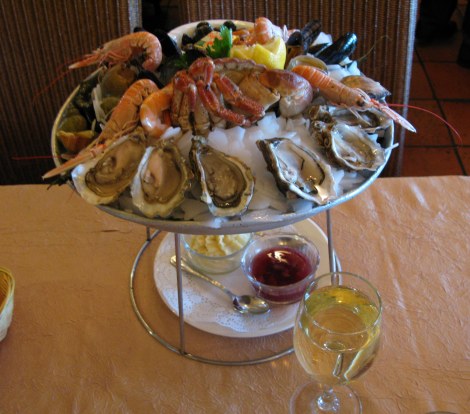
Gourmet food and fine wine with a view of the port of La Cotinière
Before my meal arrived I sipped a glass of champagne and thought I was almost meeting the command of Lord Byron:
A woman should never be seen eating or drinking,
unless it be lobster, salad, and champagne:
the only true feminine and becoming viands
Not wishing to appear too proper, I dispensed with the salad.
The meal of shellfish and crustaceans makes you work for your meal and is better completed when lubricated by a nice amount of delicious Oléron wine.
As the level in my glass grew lower I looked at the tools that had been supplied with the platter.
Having originally wondered about the smaller utensils provided, I found them particularly well-designed for ejecting the contents of the smaller varieties of shellfish.
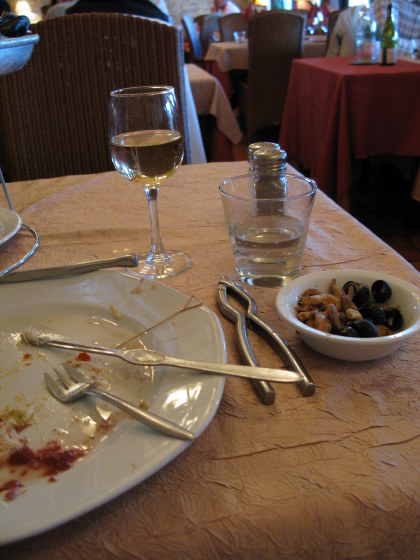
Apart from having such a wonderful setting, with La Cotinière port right before you, Restaurant l'Ecailler is a truly fine seafood restaurant in a town of fine seafood restaurants.
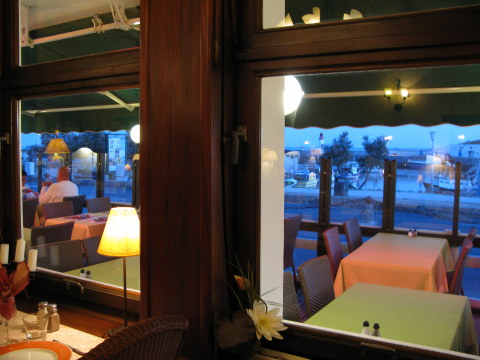
During my week on Oléron I did a survey. I told people I was in search of the perfect oyster, and asked where they, as a local, would recommend me to go to find it. I never got the same recommendation twice.
Having eaten my way across the island, I knew that this was not because nothing was exceptional. Rather, it was because there is so much exceptional dining on Oléron that you are totally spoiled for choice.
The waiting staff of l'Ecailler were delightful.
I was quite late arriving and by the time I was waiting for my dessert the staff were preparing the tables for the next day and teaching a new waitress their particular method of arranging the serviettes. This involved a particular flicking ability with the fabric pinched together at particular points.
It took several demonstration efforts before the new waitress proudly perfected it.
For the rest of us still left it was good theatre.The dark haired girl was an Audrey Hepburn lookalike and as charming as beautiful.
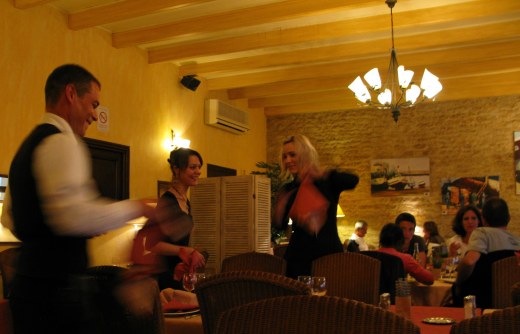
The perfection of the finished settings showed what a little fun in learning can do.
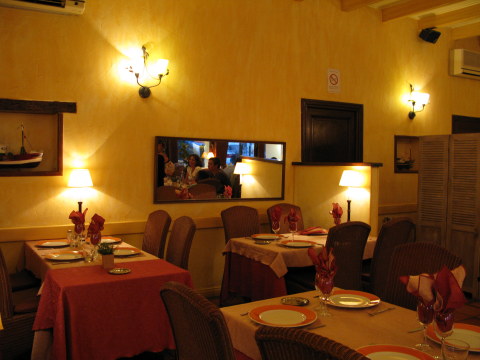
The village of La Cotinière
The next day I parked my car in a parking lot just off the main street of La Cotinière and was amused by the designer-shirt-wearing scarecrow above the ripening cherries in the neighbouring yard.
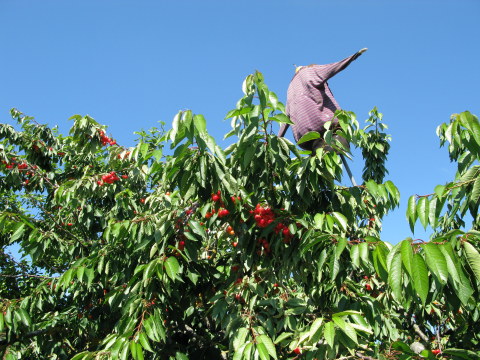
There are lots of small boutique shops in La Cotinière but it took a little while to reach them because I was waylaid by chocolate and marzipan at this fantastic confisserie/pattisserie.
The patisserie was a hazard beside the cash machine and I am sure this strategically placed temptation had relieved many a person of their freshly dispensed money.
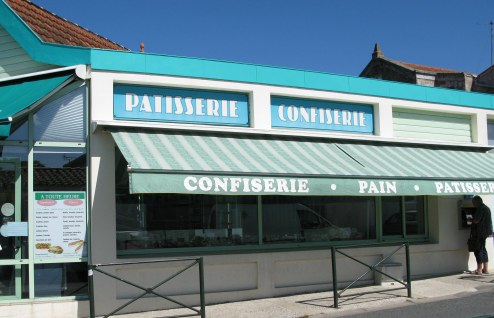
Here it was hard to choose between local pastries, jam…
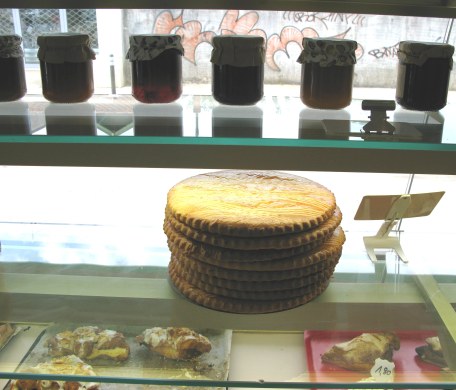
…nougat and fondants…
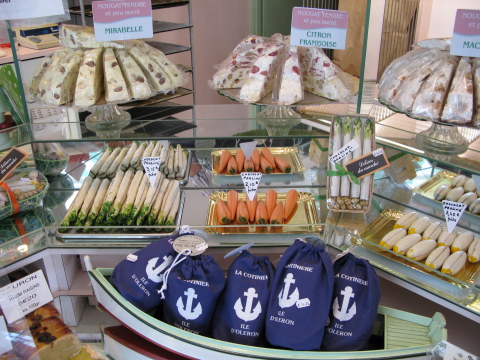
…or between a wide range of caramels.
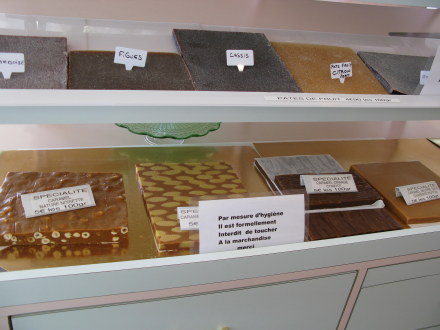
And then there are the Parisian-quality cakes.
The cakes won, and I took my purchase to the port to enjoy.
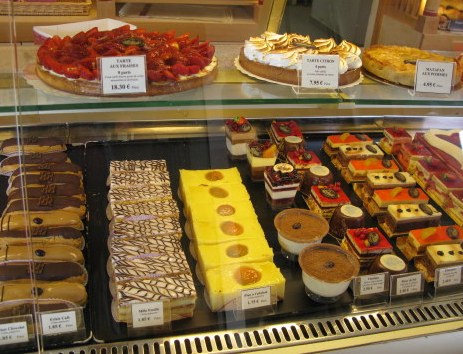
Holidays, dreams,
and the magic of a place
I could live here, I thought.
Good white wine, good red wine (that is something you don't often find being produced in the same place), delicious seafood, the best oysters in France (that should get some comments from readers who have their own favourite oyster destinations), island beef and lamb, lovely designer goods, delicious temptations for the sweet tooth – and spectacular scenery.
The only thing wrong is that 'in season' it is over-run by French holiday makers. It might be a secret to those outside France, but this is a favourite holiday destination for many throughout the whole nation.
There is much here on the island of Oléron to indulge the senses – and as Mae West said:
You only live once
But if you do it right,
once is enough
Sitting by the port where the fishing nets were laid out to dry I was delighted by a lovely fishing boat wind vane.
The art of nets and buoys
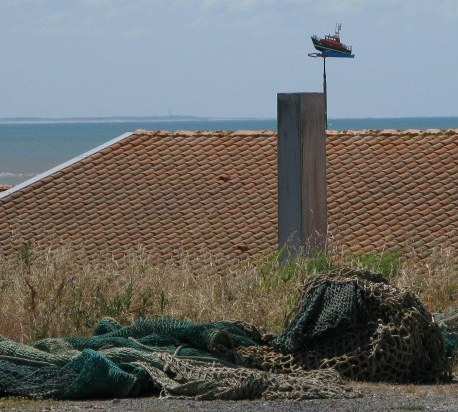
The dark turquoise nets and buoys of the trawler….
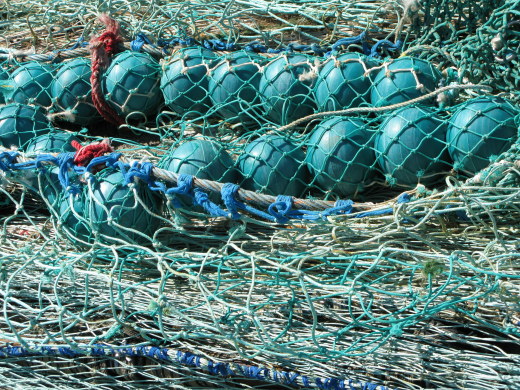
…the long lines of the troller…
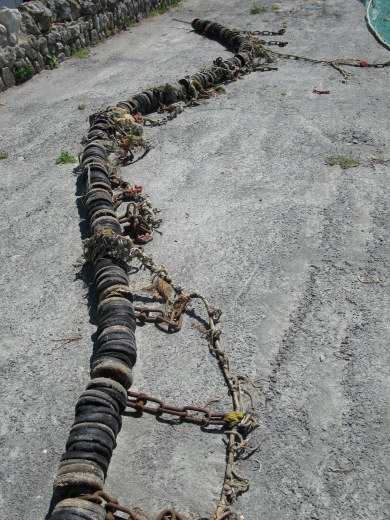
…were laid out in each direction for inspection and repair where required.
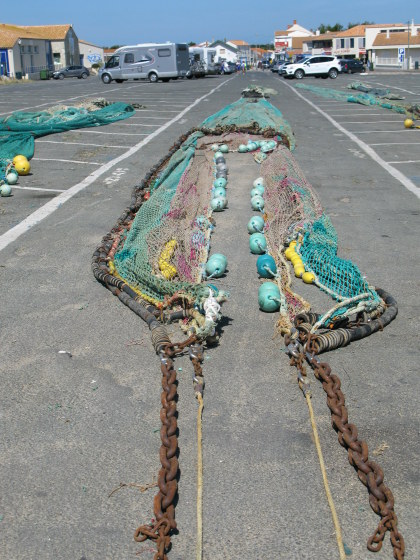
They took up a fair section of the parking lot.
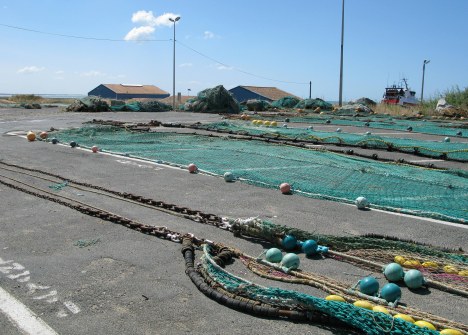
It seemed that, once inspected, they were piled into heaps to be retrieved later.
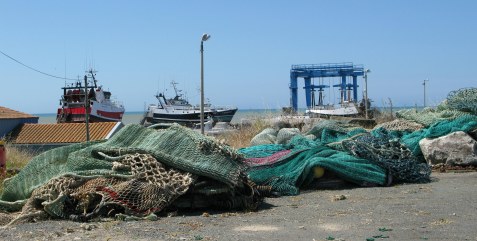
I wondered how people knew which was which.
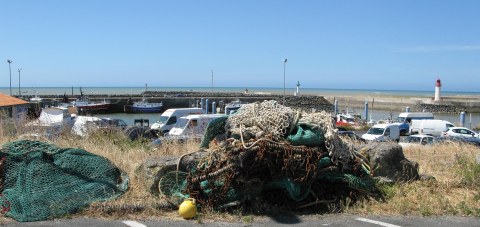
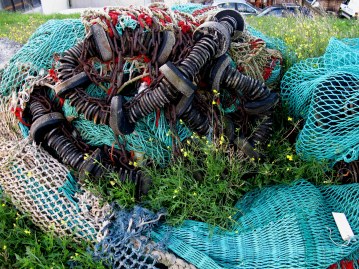
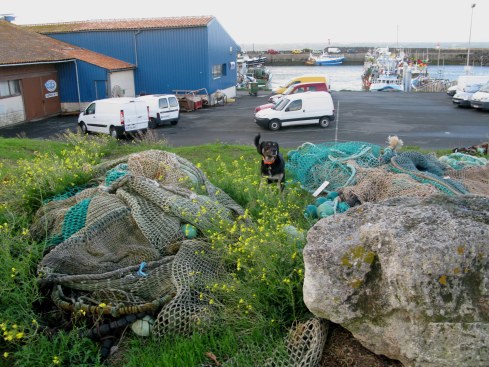
The rules of the sea:
the 'Rolls of Oléron'
foundation of British Maritime Law
Apart from its importance as a fishing port – and being renowned for its oysters – the French island of Oléron is marked into history as the place where the first European maritime laws were set into charter.
These laws, known as 'the Rolls of Oléron' were based on the Assizes, or laws of the ancient Kingdom of Jerusalem, established by the Crusaders on the Levant.
At its peak, this kingdom of the Crusaders extended from the Mediterranean across the Sinai desert to include what is now Israel, Lebanon, and the Palestinian Territories.
Maritime transport being the key to power and the shipping of goods being a vital component of feeding this power, there were many disputes that arose.
These could be on a variety of issues: over ships provisioning, privateering, damage at sea that affected the cargo, changed routes due to weather that affected the arrival of goods destined for another port – and who was to take responsibility for the ensuing loss, as well as the handling, provisioning and rights of the crew.
The issues were numerous.
The Rolls of Oléron (often later called the 'Rules' of Oléron) addressed all these issues in detail. Eleanor of Aquitaine declared them law in 1162 following her return from the second Crusade. Eleanor’s husband, King Henry II, formerly Henry Plantagenet, had remained and it was thus in her role of regent that she enacted what was to become the basis for British Admiralty Law to this day.
At the time these laws were enacted, Oléron was a powerful and strategic location, with the strongest Marine Guilds on the Atlantic.
As I stood looking over the lovely port of La Cotinière, I was pleased it had retained its true character despite being a favourite French holiday destination.
Its importance as a strategic stronghold has passed with the era but it seemed to me that Oléron still has held its character.
This was something I didn’t feel when visiting the island of Ré whose proximity to La Rochelle has changed its focus more noticeably from maritime affairs to tourism.
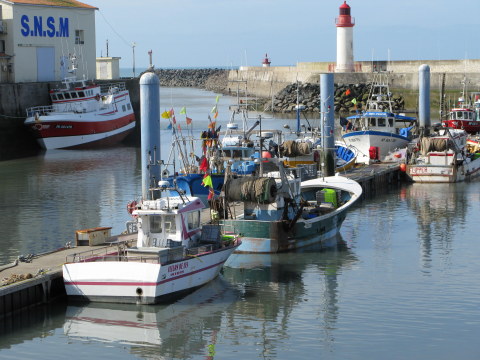
There seemed to be symmetry to life on Oléron. It was reflected in the open and friendly people and their general air of happiness with life.
Perhaps they understood the same things that Henry David Thoreau did when he said:
Many go fishing all their lives
without knowing
that it is not fish they are after.
Other Oléron Pages






